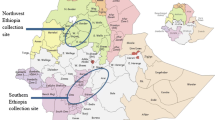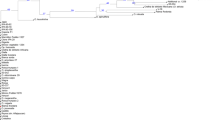Abstract
We previously developed five polymerase chain reaction-based markers (T, S, SAC, D, and A) to distinguish potato cytoplasms into six types (M, P, A, W, T, and D). As the applicability of this genotyping method for phylogenetic studies had been questioned, we applied this method to species distantly related to cultivars (four accessions of two tomato species, and 176 accessions of 29 Solanum species). The T marker uncovered two insertions, which, along with a unique S marker band, supported independency of series Piurana. The A and D markers generated unique bands to A- and D-type cytoplasms, respectively, but the SAC marker generated a similar banding pattern to the cytoplasms of both cultivated and their distantly related species. Consequently, while the cytoplasm type definition is validated only among cultivated potatoes and their closely related wild species, the developed markers, with the exception of the SAC marker, could provide useful phylogenetic information.
Resumen
Nosotros desarrollamos previamente cinco marcadores con base a la reacción en cadena de la polimerasa (T, S, SAC, D, y A) para distinguir los citoplasmas de la papa en seis tipos (M, P, A, W, T, y D). Considerando que la aplicabilidad de este método de caracterizar genotipos para estudios filogenéticos había sido cuestionada, aplicamos este método para especies poco relacionadas a variedades (cuatro introducciones de dos especies de tomate y 176 de 29 especies de Solanum). El marcador T descubrió dos inserciones, las cuales, junto con una banda única del marcador S, respaldaron independencia de la serie Piurana. Los marcadores A y D generaron bandas únicas a citoplasmas de los tipos A y D, respectivamente, pero el marcador SAC generó un patrón de bandas similar a los citoplasmas tanto de las cultivadas como de las especies con relaciones distantes. Consecuentemente, mientras que la definición del tipo de citoplasma se valida solo entre papas cultivadas y sus especies silvestres con relación cercana, los marcadores desarrollados, con la excepción del SAC, pudieron proporcionar información filogenética útil.




Similar content being viewed by others
References
Ames, M., and D.M. Spooner. 2008. DNA from herbarium specimens settles a controversy about origins of the European potato. American Journal of Botany 95: 252–257.
Ames, M., and D.M. Spooner. 2010. Phylogeny of Solanum series Piurana and related species in Solanum section Petota based on five conserved ortholog sequences. Taxon 59: 1091–1101.
Ames, M., A. Salas, and D.M. Spooner. 2007. The discovery and phylogenetic implications of a novel 41 bp plastid DNA deletion in wild potatoes. Plant Systematics and Evolution 268: 159–175.
Ames, M., A. Salas, and D.M. Spooner. 2008. A morphometric study of species boundaries of the wild potato Solanum series Piurana (Solanaceae) and putatively related species from seven other series in Solanum sect. Petota. Systematic Botany 33: 566–578.
Chimote, V.P., S.K. Chakrabarti, D. Pattanayak, S.K. Pandey, and P.S. Naik. 2008. Molecular analysis of cytoplasm type in Indian potato varieties. Euphytica 162: 69–80.
Dionne, L.A. 1961. Cytoplasmic sterility in derivatives of Solanum demissum. American Potato Journal 38: 117–120.
Gavrilenko, T.A., O.Y. Antonova, and L.I. Kostina. 2007. Study of genetic diversity in potato cultivars using PCR analysis of organelle DNA. Russian Journal of Genetics 43: 1550–1555.
Hawkes, J.G. 1990. The potato—evolution, biodiversity and genetic resources. London: Belhaven Press.
Hosaka, K. 2002. Distribution of the 241 bp deletion of chloroplast DNA in wild potato species. American Journal of Potato Research 79: 119–123.
Hosaka, K. 2003. T-type chloroplast DNA in Solanum tuberosum L. ssp. tuberosum was conferred from some populations of S. tarijense Hawkes. American Journal of Potato Research 80: 21–32.
Hosaka, K., and R. Sanetomo. 2009. Comparative differentiation in mitochondrial and chloroplast DNA among cultivated potatoes and closely related wild species. Genes & Genetic Systems 84: 371–378.
Hosaka, K., and R. Sanetomo. 2012. Development of a rapid identification method for potato cytoplasm and its use for evaluating Japanese collections. Theoretical and Applied Genetics 125: 1237–1251.
Jacobs, M.M.J., R.G. van den Berg, V.G.A.A. Vleeshouwers, M. Visser, R. Mank, M. Sengers, R. Hoekstra, and B. Vosman. 2008. AFLP analysis reveals a lack of phylogenetic structure within Solanum section Petota. BMC Evolutionary Biology 8: 145.
Kawagoe, Y., and Y. Kikuta. 1991. Chloroplast DNA evolution in potato (Solanum tuberosum L.). Theoretical and Applied Genetics 81: 13–20.
Mori, K., N. Mukojima, T. Nakao, S. Tamiya, Y. Sakamoto, N. Sohbaru, K. Hayashi, H. Watanuki, K. Nara, K. Yamazaki, T. Ishii, and K. Hosaka. 2011. Germplasm release: Saikai 35, a male and female fertile breeding line carrying Solanum phureja-derived cytoplasm and potato cyst nematode resistance (H1) and Potato virus Y resistance (Ry chc ) genes. American Journal of Potato Research 89: 63–72.
Plaisted, R.L., and R.W. Hoopes. 1989. The past record and future prospects for the use of exotic potato germplasm. American Potato Journal 66: 603–627.
Rodríguez, F., and D.M. Spooner. 2009. Nitrate reductase phylogeny of potato (Solanum sect. Petota) genomes with emphasis on the origins of the polyploid species. Systematic Botany 34: 207–219.
Ross, H. 1986. Potato breeding-problems and perspectives. Berlin: Verlag Paul Parey.
Sanetomo, R., and K. Hosaka. 2011. A maternally inherited DNA marker, descended from Solanum demissum (2n = 6x = 72) to S. tuberosum (2n = 4x = 48). Breeding Science 61: 426–434.
Sanetomo, R., and K. Hosaka. 2013. A recombination-derived mitochondrial genome retained stoichiometrically only among Solanum verrucosum Schltdl. and Mexican polyploid of wild potato species. Genetic Resources and Crop Evolution. doi:10.1007/s10722-013-0007-z.
Spooner, D.M., and R.T. Castillo. 1997. Reexamination of series relationships of South American wild potatoes (Solanaceae: Solanum sect. Petota): evidence from chloroplast DNA restriction site variation. American Journal of Botany 84: 671–685.
Spooner, D.M., and A. Salas. 2006. Structure, biosystematics, and genetic resources. In Handbook of potato production, improvement, and post-harvest management, ed. J. Gopal and S.M.P. Khurana, 1–39. Binghampton: Haworth’s Press.
Spooner, D.M., K. McLean, G. Ramsay, R. Waugh, and G. Bryan. 2005. A single domestication for potato based on multilocus amplified fragment length polymorphism genotyping. Proceedings of the National Academy of Sciences of the United States of America 102: 14694–14699.
Spooner, D.M., D. Fajardo, and G.J. Bryan. 2007a. Species limits of Solanum berthaultii Hawkes and S. tarijense Hawkes and the implications for species boundaries in Solanum sect. Petota. Taxon 56: 987–999.
Spooner, D.M., J. Núñez, G. Trujillo, M.D.R. Herrera, F. Guzmán, and M. Ghislain. 2007b. Extensive simple sequence repeat genotyping of potato landraces supports a major reevaluation of their gene pool structure and classification. Proceedings of the National Academy of Sciences of the United States of America 104: 19398–19403.
Spooner, D.M., F. Rodríguez, Z. Polgár, H.E. Ballard Jr., and S.H. Jansky. 2008. Genomic origins of potato polyploids: GBSSI gene sequencing data. The Plant Genome, a Suppl. to Crop Science 48(S1): S27–S36.
Spooner, D.M., M. Ames, D. Fajardo, and F. Rodríguez. 2009. Species boundaries and interrelationships of Solanum sect. Petota (wild and cultivated potatoes) are drastically altered as a result of PBI-funded research. ASA-CSSA-SSSA Annual Meeting Abstracts. Paper No. 54478.
Sukhotu, T., and K. Hosaka. 2006. Origin and evolution of Andigena potatoes revealed by chloroplast and nuclear DNA markers. Genome 49: 636–647.
Sukhotu, T., O. Kamijima, and K. Hosaka. 2004. Nuclear and chloroplast DNA differentiation in Andean potatoes. Genome 47: 46–56.
Acknowledgments
We thank the US Potato Genebank (NRSP-6), Sturgeon Bay, Wisconsin, United States, for providing the Solanum seeds used in this study, Dr. David M. Spooner for kindly checking taxonomic identities with his updated taxonomy, and Ms. Shizuka Souma for technical assistance. This study was supported by Calbee, Inc., Tokyo, Japan, and Calbee Potato, Inc., Obihiro, Japan.
Author information
Authors and Affiliations
Corresponding author
Rights and permissions
About this article
Cite this article
Hosaka, K., Sanetomo, R. Application of a PCR-Based Cytoplasm Genotyping Method for Phylogenetic Analysis in Potato. Am. J. Potato Res. 91, 246–253 (2014). https://doi.org/10.1007/s12230-013-9344-x
Published:
Issue Date:
DOI: https://doi.org/10.1007/s12230-013-9344-x




